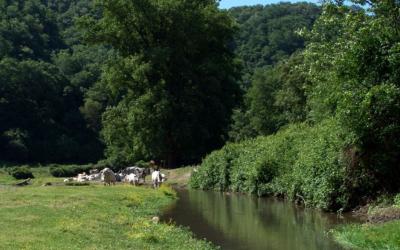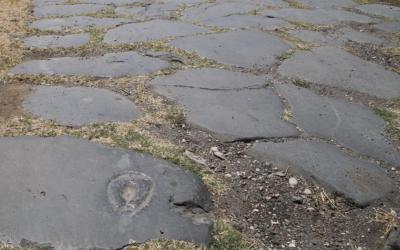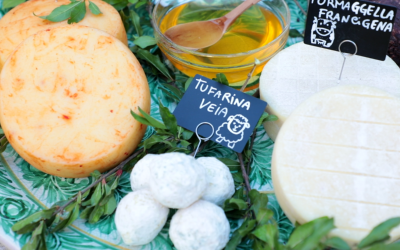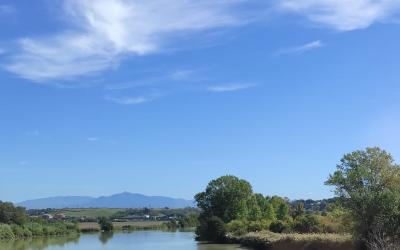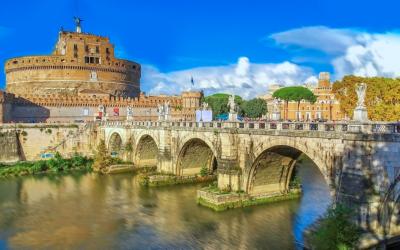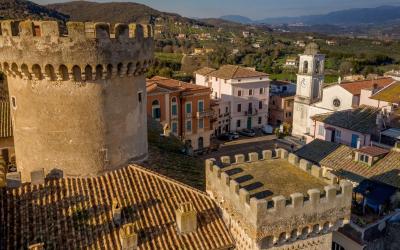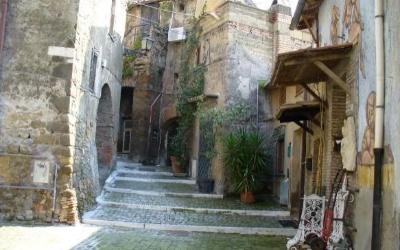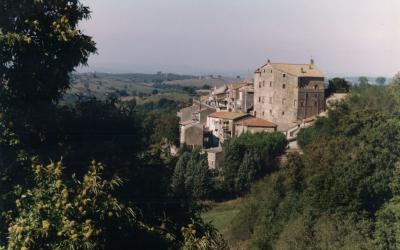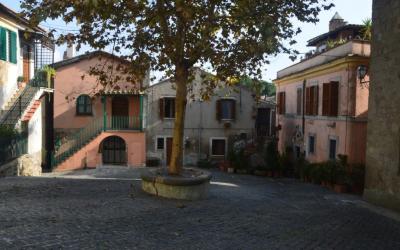Discover the village and the Monte Musino and Veio Park nature trails.
Sacrofano stands on the slopes of Monte Musino on the rim of the caldera of an ancient vulcan, the Sacrofano vulcan,one of the most important explosive centres of the Sabatino volcanic district. The wealth of green areas and the low density population makes the municipal territory unique and unspoiled from a naturalistic point of view. Among the most interesting, a large area of virgin woodland, called Macchia di Sacrofano, which includes the hill of Monte Musino, at the top of which are the remains of a medieval fortification and traces of an earlier place of worship, Sacrum fanum, from which Etruscan underground aqueducts which fed the ancient city of Veio near Isola Farnese ,branched off.
The above-mentioned green areas and the Monte Musino forest can be visited through a dense network of paths on foot, on horseback and by mountain bikes.
Very suggestive are the solfataras, two quarries that are not in use and where, at sunset, the white walls are illuminated with a magical light, offering a unique experience.
You can enter into the old village through a gate, preceded by a double flight of stairs and followed by two arches, there you will find the Church of St John the Baptist. From the outside, the Romanesque bell tower dating back to 1100 stands out, while the building, as well as the artworks inside, are from the Renaissance period.
Walking through the alleys, protected by the walls, you can also cross the old Jewish area, one of the oldest in Italy.
The main buildings in the centre include Palazzo Placidi Serraggi, in Baroque style, and nearby the Church of San Biagio, the town's parish church, built in the early 18th century. It is worth entering and looking up to admire the magnificent coffered ceiling.
POINTS OF INTEREST
- Church of St John the Baptist
The first nucleus of the Church, is formed by the hall that today coincides with the entrance, and the Bell Tower, made of perfectly squared tuff blocks, dated back to the 13th century. Between the 15th and 16th centuries, the Orsini Tower behind was incorporated , creating the current asymmetrical shape of the church.
Among the art works inside, the most notable is the frescoed apse with the Virgin Ascending to Heaven carried by angels and surrounded by saints; painted by the Roman school in the mid 17th century, it was restored in 2018 on a commission from MiBACT.
The marble altar from 1515 holds the bones of St Justin, which were found on the Via Flaminia in 1724,coming from the ancient rural church of San Marcello, now completely disappeared.
The church also houses the cast bell dating back to the time of Cola di Rienzo, from the estate of Pietrapertusa, which rang until 1799, and the carved wooden wall pulpit from 1641.
- Jewish Ghetto
In the mid-16th century, the highest part of the Castrum was transformed from a military zone into a closed residential area, ghetto, and set entirely to the Jewish community from Fiumefreddo Bruzio, in the province of Cosenza. Accessible by a single door that is closed at sunset and reopened only at dawn.
The racial laws sanctioned by Pope Paul IV Carafa's encyclical Cum nimis absurdum on 1555, are reported in the Statute of Scrofano (1554) with a series of restrictions on the rights of the Jewish community that impose on its conduct. As the population grew, houses were raised, creating a layout of narrow streets with tall houses, equipped with stairs, and very crowded. In a private house even today there is the sacred cupboard where the Sefer Torah, the scrolls of the law, were kept.
- Prisons
The prisons of Scrofano probably date back to the 16th century, during the Orsini dominion. The narrow and high building, which encloses small rooms on two levels, was built on an arched structure dating back to Roman times.
During the 18th century, under the Chigi dominion, the prisons were raised and restored and, in the 20th century, above them there was the seat of the Municipality, but after the war (1945) the whole building was converted into private housing. It is still possible to recognize the windows with their button-eye iron grilles.
- Church of San Biagio
The Church of San Biagio, dating back to the second half of the 15th century, is the current parish church of the village.
Parts of Renaissance frescoes can be found in the apse, but the structure was remodeled in the 18th century with various interventions including the creation of a magnificent gilded coffered ceiling and canvases recalling the miracles of the patron saint to whom the church is dedicated.
- Serraggi Palace
Palazzo Placidi-Serraggi takes its name from the noble families that from the beginning of the 18th century were linked with the powerful Chigi family. In the centre of the façade there is the coat of arms with oak and eagle dated 1707. Note the admirable stuccoes that recall other examples of the style known as 'Roman Baroque'.
- Oratory of St Blaise (formerly Oratory of the Suffrage or Placidi)
Built by Placido Placidi in the early 18th century as the chapel of the Placidi-Serraggi palace, it was the church dedicated to St Edward the King where a confraternity of worship and charity for the poor people of Sacrofano had its seat.
With renovation and redevelopment work, it has become a parish theatre on the ground floor, while on the upper floor houses the permanent exhibition 'I Cavalli di Tanzi', 25 paintings whose main subject is the horse, by the artist Gaetano Tanzi, a symbol of elegance, boldness and generosity, created between 1960 and 2000 and donated to the Municipality of Sacrofano
TRADITIONAL FOOD
- Tegamaccio: a poor dish with tomato, potato, onion and Roman mint made in layers.
- Morsoletti: typical local sweets made with honey and hazelnuts which in ancient times used to replace sweets
- Ciambellette: soft, round-shaped biscuits that accompanied breakfast, found in the typical recipes of many towns in Lazio area.
- Typical local cheese from the award-winning producer Alchimista Lactis, which processes carefully and without additives km0 raw materials. His Ricotta Vecchia Maniera was awarded with the Premio Roma as the best ricotta in Lazio or its Caciotta Gajarda among the best ten cheese in Italy.
- The extra virgin olive oil cold-pressed in the local mill, a product of high quality and naturalness for the uncontaminated environment in which the olive trees grow.

